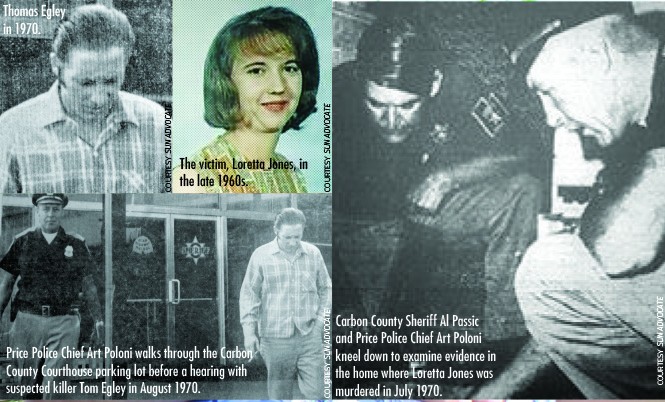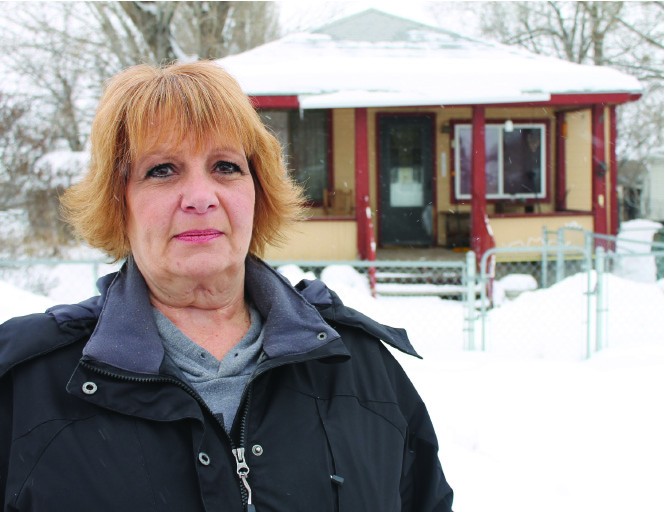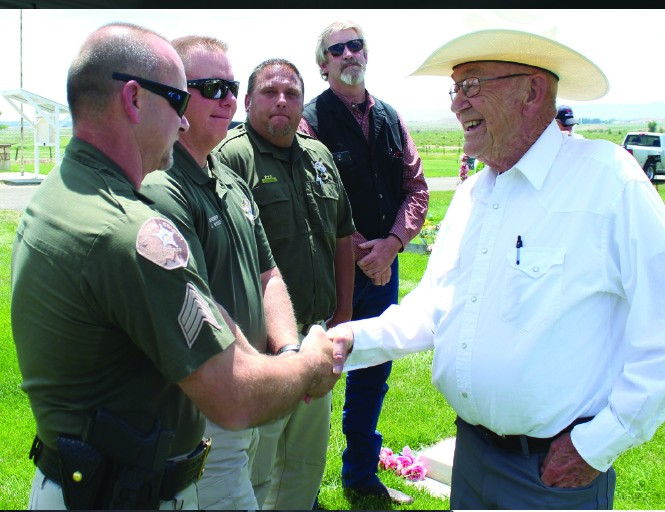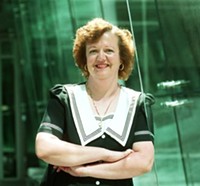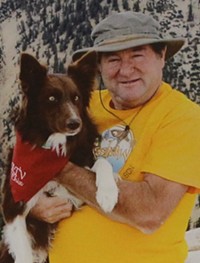Loretta's Justice
45 years later, cold murder case in rural Utah heats up.
By Carolyn Campbell and Richard ShawFor the past seven years, Carbon County Sheriff's Detective David Brewer drove around with a piece of jewelry hanging from his police cruiser's rear view mirror. "It has helped to remind me of what I was doing," he says. "It got me through some tough times when I didn't think we could keep it going."
That small, bedazzled leprechaun reminded him daily that he was working on a case that needed to be solved; the 46-year-old murder of Loretta Jones—a 23-year-old mother who was stabbed 17 times, raped and strangled. The woman's daughter gave him the charm after learning that he was resolutely investigating the murder.
For Heidi Jones-Asay, the time that Brewer spent working on her mother's case was long in coming. She was 4 years old the day she found her mother dead, lying in a pool of blood. For the next four decades, she kept the fire alive to find the killer.
"I knew who did it all along," she says. "But I just couldn't get anyone to listen to me, to reopen the case." Thoughts of the man who killed her mother haunted her while she was a child living with her grandmother after the tragedy. She told the older woman, "Tom is going to come get me," referring to Thomas Egley, a local drifter. For all intents and purposes, he was always the only real suspect. Yet, just before Christmas 1970, a judge dropped charges against him, saying there was not enough evidence for trial. In the subsequent years, reaching the truth was increasingly elusive.
Egley lived many different places before and after he killed Loretta Jones. He never had a stable home life. He lived with women, married three times, fathered five children and mostly kept to himself in the years before his arrest last July.
It's hard to understand what kept him from being prosecuted for murder right away as by the time he was arrested, a seemingly iron-clad case had been made.
A Sun Advocate photo published late that summer shows Egley walking, cigarette in hand, across the parking lot of the then-Carbon County Courthouse, casually speaking with Price Police Chief Art Poloni, who was also walking with him but about 15 feet away. This was on the day when he was taken to court to see if he would stand trial.
Was this casual approach—Egley wore no shackles nor handcuffs—just a product of the times? Or was the whole affair not handled by the book?
That question will never be answered as the then-30-year-old got off scot-free and lived out most of his life abusing drugs and alcohol and getting in and out of minor scrapes with the law while an eastern Utah family grieved daily.
What really happened during the night of the killing was never definitively known until now—now that Egley is housed at the Utah State Prison. After Jones-Asay talked with Brewer about her mother's murder at the 2009 Helper Art Festival, he began investigating with only a couple of local newspaper stories as leads—and very little else. By then, most people involved in the case were dead or so old, there was concern that their memories might fail during testimony. Police records and, initially, all of the court records that could help him sleuth the case, had long since been lost.
Brewer had reason to believe the original suspect committed the murder. Shortly after beginning the investigation, he knew that Egley was still alive, living in Rocky Ford, Colo. He knew, too, that somehow he would find a way to prove that the now-76-year-old was the killer.
Events of that night as spelled out in news reports are fairly detailed, yet incomplete. Brewer still needed to place Egley near or at Jones' home. He needed someone who could prove the drifter was there that night. And while no one seemed to be able to do that in 1970, with the help of many people, Brewer was recently able to put Egley near the scene at the time of the killing.
On July 30, 1970, a man accosted a young girl in the 400 South and 700 East block of Price. She was riding her bike in the street near dusk that evening when he grabbed her from behind, clamping a hand over her mouth. She was chewing a wad of bubble gum. In fear, she forced it out and he let her go. As she ran toward the basement apartment where she lived, he started to run away. Her brother, a friend and her stepfather were home at the time. They saw the bike fall, but at first didn't see the attack. As they ran outside, she told them what happened. They gave chase, but lost the man as he ran south in the dimming light of dusk. Police were called and they began an investigation.
The next morning, 4-year-old Jones-Asay peered through a keyhole from her bedroom into the living room of her house a couple of blocks south of where the assault was reported. The little girl saw her mother lying on the floor. She ran out of the house and encountered a neighbor boy who was searching his front lawn for night crawlers to go fishing. She said to him, "I think my mommy is dead."
The boy went to her house, looked through the door, ran home and told his mother, who also came over and looked. The police were immediately called.
Investigators found Jones wearing few clothes, surrounded in a pool of blood and showing multiple stab wounds. It was a savage sexual assault and murder. Both County Sheriff Al Passic and Police Chief Poloni were involved in the initial investigation. Officers combed the house for clues. They began to question everyone in the area.
With a small, thin-blade knife, Jones had been stabbed 17 times in the back, twice in the chest and suffered a gash across her neck. The murder weapon was never recovered. There was also no sign of a forced entry.
As police began to assemble evidence, the young girl's description of the man who accosted her the previous night began to resemble someone Jones knew—Thomas Egley. However, before local authorities began to act on that possible lead, Provo police heard the description and arrested a man there first, thinking he might be the one that Carbon authorities were seeking. The young girl was taken to Provo, but she said that the arrested man was not the one who'd attacked her.
FROZEN IN TIME
As the investigation progressed, persons of interest developed in the case. The strongest lead came from an anonymous phone call concerning Egley, a young man who lived at the Newhouse Hotel in Helper. At that point, he became the focus of the investigation. Egley was brought in for questioning, and he reportedly admitted that he had been in Price that night, but that was all. Then he asked for a lawyer. Further questioning resulted in no information. Police did not have enough to hold him, so he was released. A few days later, he was questioned again with the same result.
On Aug. 6, however, he was booked for the assault of the girl. While he was considered a suspect in the Jones murder, there wasn't enough evidence to book him. During that time, four other suspects were apprehended, but cleared of the charges. Egley was still the main suspect. On Aug. 31, after more interviews and the completion of some FBI evidence reports, Passic and Poloni arrested Egley for murder. At his preliminary arraignment before Price City Judge Tom Platis that afternoon, the court deemed Egley indigent and appointed Thorit Hatch, a Helper attorney who previously served in the Utah House of Representatives as defense counsel. Hatch was also the lawyer who advised Egley not to talk to police during the original questioning. After the arraignment was continued until the next day, Egley was remanded without bail. Hatch asked for another attorney to assist him. Arraignment was then continued until Sept. 4, when the court set a preliminary hearing for Oct. 8.
But the day of the prelim, County Attorney Dan Keller asked the judge to postpone the hearing for three reasons. First, some persons of interest who knew both the suspect and victim were recently located in Kansas. Police had not yet had a chance to speak with them. Second, some anticipated FBI reports had not been completed. Finally, Poloni was unavailable to testify because he was attending law-enforcement school in New York.
Hatch protested the continuance, saying that his client's civil rights were violated due to his long incarceration with no preliminary hearing. He stated that the police went on "fishing expeditions" concerning the guilt or innocence of his client and "had not succeeded."
"If the state has not prepared its case by now, my client should be released," Hatch told Platis.
Platis granted the continuance, providing the prosecution file an affidavit detailing its reasons for the continuance. Keller agreed. Egley was denied bail and a new hearing date was set for Nov. 5. That day, the prosecution pleaded with the judge to formally charge Egley, but he decided that there wasn't enough evidence to hold Egley for trial. The judge then ordered Egley released.
Reportedly, Egley stayed in Helper only until about January, 1971. He then moved on.
Over the years, the murder case picked up steam at least once with an additional investigation, but then continued to grow colder and colder—almost frozen in time. Some witnesses drifted away and others died. Consequently, the matter never passed the investigatory stage. At one point, according to Jones-Asay, when the Price police reopened the case in 2009, she only found out about it through someone else. She was eventually told that they couldn't find anything new. "They told me they had done everything they could, except interview the original suspect," she tells City Weekly.
Hatch, who passed away a few years ago in Sunnyvale, Calif., took anything he knew with him. Keller died in 2012.
These were the details left for Brewer when he decided to investigate. This information, other than what Jones-Asay told him, was all he had to work with. All evidence had disappeared and, until 2015, no court transcript of the original judicial hearings could be found.
DEVIL'S IN THE DETAILS
"The truth is the truth," Brewer says during a recent interview about why he worked so hard to solve a case that seemed unsolvable. "I believe in that and that it should come out."
So, he rolled up his sleeves and went to work. Shocking evidence he uncovered continued to affirm that Egley did the deed. Even more surprising was his discovery that obvious evidence was overlooked or at least never presented. He was also taken aback that Jones-Asay was never considered as a witness, regardless of her young age. She was convinced Egley killed her mother, possibly recalling something in her young mind that later became obscured by the passing of time. But Brewer was determined to see justice done. "First, I had to put Egley in the area of Price where the murder happened," he says.
Brewer discovered more detail regarding the attack on the young girl after interviewing her and her brother who chased her assailant. She told him the perpetrator was wearing an odd, multicolored hat that he dropped as he attacked her. He ran back to retrieve it before the family started to chase him. Egley was known to have such a "welder's cap." Later, a witness reported seeing a similar hat hanging on a hook by Egley's door at the Newhouse. Also, before the incident, the brother and the friend of the girl that was attacked had noticed the man who accosted her sitting on the curb near an Arctic Circle eating a hamburger. They lived just a few doors down from the fast-food restaurant then located on Main Street. The brother identified Egley as the attacker and said that he was wearing the cap.
The attack of the girl happened at dusk—probably about 9 p.m. The murder was determined to have ocurred around 10 p.m.
Price Police Officer Barry Bryner arrived first at the scene the next morning. During the investigation, Bryner told Brewer that Jones lay still in a pool of blood. Yet, before she died, she scrawled letters in blood, smearing a "T" into the carpet, followed by an "O" written over the first letter as she died. At least one person besides Bryner saw this. It was known that Jones previously dated Egley, so the "T" and the "O" were significant evidence. Yet their existence was never addressed in the hearings.
While the letters were clearly legible, it was hard to reach collaboration on this point over 40 years later as all crime photos and statements from that time went missing. However, a family member photographed the blood on the floor. For a long time, those photos were in the Jones' family picture album at Jones-Asay's grandmother's house.
"Over the years, I would look through the family photo album. Among all these happy photos were these pictures of the crime scene," Jones-Asay says. "I asked my grandmother to take them out and she finally did. Then, years later, I realized that we needed them and she found them."
The most telling photo is one of 4-year-old Jones-Asay standing in the doorway to her mom's bedroom. The blood-stained letters are on the floor in front of her. When blown up, they're quite obvious.
Later that evening, at about 11:30 p.m., Egley showed up at the Highway Rendezvous Club south of Helper with "pink spots on his shirt," a bar operator told Brewer during the investigation. She said he was adamant that he needed to find someone who was driving into Helper to get a ride from them. However, the Newhouse was only about three blocks away so she didn't understand why he needed a ride, but he found one. He left sometime before midnight with another man.
Egley lived at the Newhouse with his pregnant girlfriend. She told Brewer that he didn't come home until "3 or 4 a.m." When he arrived, she chewed him out for getting back so late. She said he went into the bathroom and took a bath in his clothes. He then took the clothes off and put them in a bag by the door. The next morning he got up early and told her he was going to wash the clothes. He asked her if she had any laundry she wanted him to do.
"This was highly unusual," Brewer says. "She said that he never did the laundry."
He left and apparently went to the laundromat. In those days, coal furnaces heated much of the town and there were burn barrels scattered around town used for disposing "clinkers," the leftover furnace ash and rock. Despite it being summer, the barrels smoldered during warm weather from people burning trash. That morning, a bar operator across the street from the laundromat saw Egley standing by a barrel with smoke coming from it.
All these details, witnesses, stories and information were available to authorities in 1970.
"Had DNA testing been available then, the case would have been a slam dunk," Brewer says. "But with so much evidence left out or not found, it just ended."
Starting a cold case over is much harder than investigating the original. Still, as things added up, Egley became an increasingly likely prime suspect.
TIME HEALS ALL WOUNDS?
In 2010, Brewer traveled to Colorado to interview Egley, who denied all involvement. However, when the wily investigator asked him a particular question, Egley's answer was telling.
"I asked him if we did find the person who murdered Loretta after 40 years of looking for them, what should happen to them."
Egley said that would depend on whether the person had committed any more murders since.
A break in the case came when Brewer was given the supposedly missing court transcripts by the court reporter who was working at the time. He had talked to her years earlier, because the transcripts were not in the county files. At the time, she said she didn't think she had anything on it.
"I was talking with County Attorney Gene Strate, and at the end of the conversation, he said that some lady had dropped something off for me," Brewer says. "It was the transcripts."
They provided much more insight into what happened and who testified than he had from other sources. The case took another leap forward.
Once Brewer visited Egley, the suspect became increasingly nervous. Brewer's second visit made him even more agitated. Then, last summer, Brewer announced that authorities planned to exhume Jones' body to look for DNA. At that point, Egley began to crack. Brewer made sure that Egley knew about the exhumation, despite the fact that he lived more than 560 miles away. Egley began to ask people whether they thought there could be any DNA left in a body after that long. Later, he asked a neighbor if she could take care of his animals if he had to go away for awhile. Then he told her what he had done. The neighbor contacted Brewer and told the detective about the confession.
Prior to that contact, the Utah Attorney General's Office told Brewer they thought there was enough circumstantial evidence to convict Egley when the detectives presented them with the information. But one of the lawyers there joked that it would sure be a lot easier if he could come up with a confession.
In retrospect, Brewer smiles at that comment.
Soon after Egley's neighbor contacted them, Brewer and Carbon County Sheriff's Detective Wally Hendricks visited Egley in Rocky Ford once more.
"I didn't even have to ask him a question," Brewer says. "He began the story and then everything just flowed after that."
Egley's story was very close to what Brewer had supposed. He denied some aspects, saying he did have sex with Jones, but hadn't raped her. He further admitted to killing her with a pocket knife that he threw into Price River from a Helper bridge soon after the killing. His story included how he got to Price, that he ate at Arctic Circle and that he later ended up at her house. He made the chilling claim that he asked her for sex and she said no, then went into the kitchen. When she returned, he killed her.
The U.S. Marshal's Service arrested Egley on Aug. 18, 2016, then extradited and booked him into the Carbon County Jail on Aug. 26.
Throughout the fall of 2016, hearings on the case continued. The once young, strapping man that some remembered was now a shriveled, bent, elderly individual who, on his first court appearance, looked older than his 76 years.
"I expected a monster, but he was just an old man," Jones-Asay says after first seeing him.
After much finagling, a plea deal was reached. Egley admitted to the murder, but not the rape. However, he still didn't seem to get it. Apparently, like his answer to Brewer's question when they met in Colorado, he remained under the illusion that just because he hadn't done anything since, he should be let go.
"I don't understand why they are going back to [something that happened] in 1970, 46 years ago," Egley told Judge George Harmond in his 7th District courtroom as Harmond asked questions to be sure that Egley understood the plea deal.
On Nov. 22, 2016, Egley was sentenced to 10 years to life in prison for second-degree murder. And, for the first time, Jones-Asay got to unload 46 years of pain, misery and toil to achieve justice for her mom.
Facing Egley in court, she said, "My mother is my hero. She never screamed or called out when she was being murdered. She protected me and I found her in a pool of blood. How does that make you feel, Thomas Egley?"
The man who she knew all along had caused the death of her mom finally went to prison. Jones-Asay later said that if he ever comes up for parole, she will be there "to be sure he never walks as a free man again."
Looking at him, few expect he will survive 10 years. Even if he does, it's not hard to figure what a parole board would do.
So the case is solved; all is done.
Well, maybe not. Jones-Asay said a lot of other people face similar circumstances in their lives—having someone taken and not having resolve. She is now working with various groups that have family and friends in similar situations. She is proof that perseverance can pay off, even when it seems time has taken away the chance for justice.
As for Brewer, after such a long investigation, is there a void to fill?
"I am not at the point where I have a hole in my life from spending so much time working on this yet," he says. "I don't know if I ever will feel that."
He also points out that there are still loose ends on evidence and aspects of the case that he would like to know more about. He might even interview Egley again, in prison, to get more answers.
And, of course, a successful detective, especially one who solves such a long-running case, receives more requests about other cold cases that need to be solved. He has been inspired by doing the right thing, and finding that "truth" he talked about.
And the little leprechaun? It still hangs from the visor in his F-150.
More by Carolyn Campbell
-
Dating counselors help singles move past relationship hiccups and get to the next date.
Looking for Love
- Feb 7, 2024
-
How DNA experts and law enforcement uncover hidden identities.
Written in Bone
- Jan 24, 2024
-
City Weekly's year-end guide to getting through the holidays and closing out those Christmas lists.
Gift Guide 2023
- Dec 6, 2023
- More »
Latest in Cover Story
Readers also liked…
-
Forget the family pedigree—Robert F. Kennedy Jr should not be the next president of the United States
Trojan Horse
- Jun 21, 2023
-
Women decry harassment and toxic culture at St. George auto dealership
Men at Work
- Oct 11, 2023



